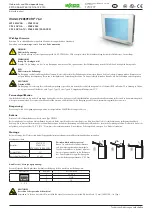
Lucent Technologies Lineage
®
2000 ECS Battery Plant J85500D-3
3 - 12 Engineering, Planning and Ordering
Issue 5 January 1999
After the total drop from the batteries to the load is determined,
the actual end voltage of the batteries can be derived from the
minimum input voltage to the load (2).
22. Actual battery string end voltage: ____ volts
23. Actual battery cell end voltage: ____ volts
Since most battery vendors provide capacity information as a
function of end voltage, item (23) is important in the selection of
a specific battery. If (23) is below the manufacturer's
recommended discharge voltage, low-voltage battery
disconnect/reconnect may be helpful in preventing battery
damage from deep discharge. In attended locations with back-up
ac power, low-voltage disconnect/reconnect may not be
necessary.
Calculating
voltage drop
A useful formula to relate voltage drop, cable length and cable
size is:
VD = (K x I x L) / CM , or CM = (K x I x L) / VD
where:
VD = allowable voltage drop, in volts
CM = conductor size in circular mils
K = 11.1 for copper at 78°F (25.5°C)
I = appropriate current drain, in amperes
L = conductor length, in feet
The formula may be applied to one-way conductors or to loop
circuits (i.e. paired power and return conductors). The value of
K in the above expression increases with increasing conductor
temperature.
Conductor
ampacity
Two criteria are used to select the actual wire gauge of a given
conductor. These two criteria are ampacity and voltage drop.
Ampacity is the current that may be carried safely without
overheating. In relatively low voltage/high current systems, such
as dc distribution, voltage drop limitations are often the
















































